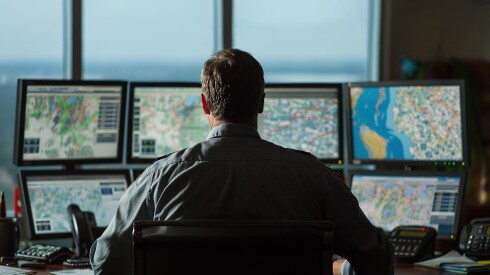-
State Police have spent more than $40 million during the last two years to buy 2,000 body cameras, software, and expanded-view cameras for 1,400 patrol vehicles. All personnel are now equipped, weeks ahead of time.
-
Based in Michigan, the data-sharing operation has about 250 agencies, with 2,000 members anticipated by 2030. One of the technology leaders behind this push details what’s coming next, and why.
-
A two-month pilot study of moving violations near school buses in Nevada's largest county found 6.1 violations each day per bus. Now the State Assembly is considering a bill to allow schools to use enforcement cameras.
More Stories
-
Officials in Alabama's Morgan and Limestone counties report that a child playing with a parent's smartphone is the most common cause of an accidental call to 911. Apple Watches' fall detection feature is another culprit.
-
When residents of a ritzy West Los Angeles neighborhood experienced an increase in burglaries last year, they decided to invest in technology for the police department to fight the problem.
-
The city of around 25,000 will deploy 16 cameras to be used in open cases or other specific circumstances, such as finding suspects or missing children. A grant will fund about two-thirds of the devices.
-
Heat played a role in more than 500 deaths in Nevada last year. A legislative committee wants more information on when, where and how many residents are left without AC if they fail to pay when temperatures climb.
-
Public safety agencies are using drones to provide up-to-the-minute overhead coverage for officers on the ground. Police in Dunwoody, Ga., have used them to track suspects and find incident locations.
-
Legislation headed to the state Senate floor would let police statewide use drones to respond to 911 calls in progress, at crash scenes ahead of arriving officers and to chase fleeing suspects.
-
BRINC and SkySafe will work with the tech giant to provide better drone operations for first responders, reflecting a larger trend in government. BRINC also says it has raised $75 million in a new funding round.
-
An eight-month pilot program resulted in law enforcement recovering about 170 cars and arresting nearly 300 people, and it helped solve homicides, robberies and hit-and-runs, according to police.
-
Robots offer potential for public safety, but state governments — working with a big name in robotics — are grappling with how to regulate them, especially as the prospect of weaponization raises urgent concerns.
-
Drones are quickly taking on more roles in law enforcement, disaster management and other tasks. Their latest role is arriving at emergency situations before humans do, collecting information for police.
-
Moving to Next-Gen 911 is more than just a technical challenge; it's a moral imperative as public safety agencies work to meet the needs of all Americans, including those with disabilities or language barriers, during emergencies.
-
WaveAerospace is building drones to fly in weather that others cannot, including heavy winds, precipitation or even icing conditions by redistributing waste heat produced by onboard systems.
-
The State and Local Cybersecurity Grant Program expires in September — but state CIOs told a congressional subcommittee Tuesday the program is a success that should be built on, not ended. Its future remains unclear.
-
Gov. Mike DeWine’s multibillion-dollar transportation budget, which he signed late Monday, will bar counties and townships from operating traffic camera programs. A 2015 law closely regulated their use for ticketing.
-
Some parents oppose legislation that would ban cellphones in Georgia public schools, arguing that the devices are essential for communicating with their kids in the event of a school shooting.
-
Distracted driving is so pervasive in the Minneapolis area that law enforcement is turning to artificial intelligence cameras to spot motorists who are illegally using their phones while behind the wheel.
-
Since 2019, the Traverse City Police Department has spent $28,000 to purchase tech tools to help officers identify unknown substances and intoxication levels, including one TruNarc device.
-
While artificial intelligence and SaaS may sometimes seem like buzzwords, they're necessities for court systems that want to continue to provide accessible and efficient judicial services.
Most Read



























